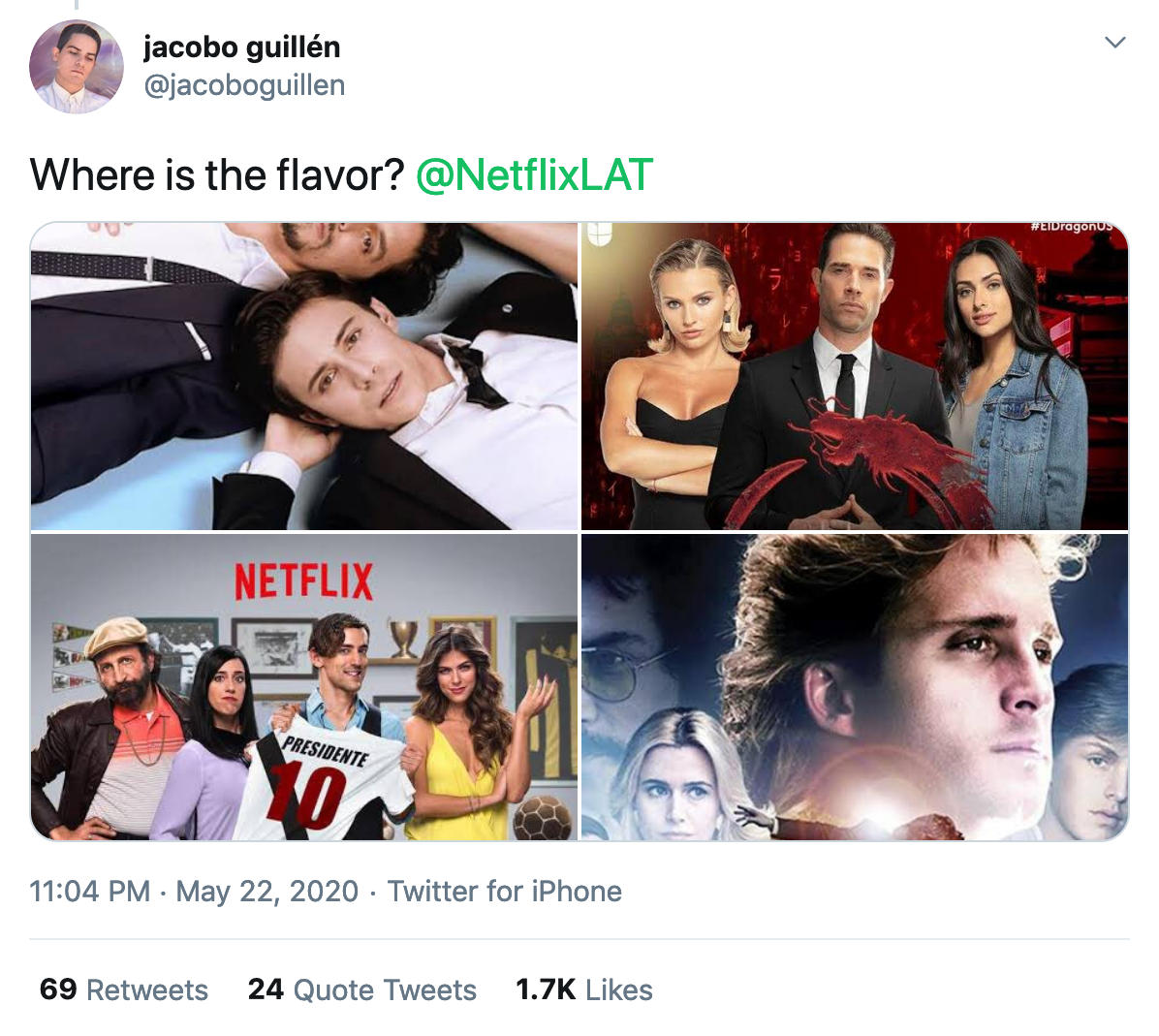
In February 2019, Netflix chief content officer Ted Sarandos announced that Netflix Mexico would produce fifty television shows and films over the following two years, making it the platform’s international territory with the most targeted productions. The promotional video following the announcement features Sarandos driving around Mexico City, picking up six of the stars of Netflix Mexico original series, and engaging in a kind of carpool karaoke to one of Luis Miguel’s songs. By putting together these six actors, the video intends to showcase the diversity of content that the streaming service offers to Mexican audiences: reality TV, thriller, comedy, musical. Implicitly (and perhaps unwittingly), the promo also illustrates a key similarity among all these stars: they are all white.
In the spring of 2020, the whiteness of Netflix Mexico’s programming has returned as a topic of conversation. On social media, this renewed discussion has been bolstered by the trend of calling out “cosas de whitexicans,” i.e. media and cultural fads that foreground white (usually affluent) Mexicans. For instance, a widely popular tweet featuring the all-white cast pictures of La Casa de las Flores (2018-2020), Control Z (2020), Made in Mexico (2018), and Monarca (2019) points out that this is “what Mexicans look like according to Netflix.”
More notably, Netflix talent impacted by racism in production and reception contexts have unequivocally made their concerns heard. In a recent New York Times op-ed, the star of Roma Yalitza Paricio writes of the racist backlash on social media that she suffered following her Oscar nomination. (She does not mention the brownface sketch mocking her on national television or the actresses who allegedly conspired to prevent her from a nomination to the Mexican film awards). Amidst the summer 2020 Black Lives Matter protests, Tenoch Huerta (of Narcos: Mexico) tweeted “When you’re done supporting the much-needed anti-racism movement in the United States, can we talk about racism in Mexico? Or is that still taboo?” Long outspoken on the rampant racism in Mexico’s screen industries, Huerta repeatedly receives pushback whenever he brings up these issues on social media. Paradoxically, his association with Netflix has allowed him greater recognition to address issues of racial disparity even as the platform emerges as a prime example of these issues.
In my In Focus article for the Journal of Cinema and Media Studies, I argue that Netflix Mexico is a middle class platform in terms of access, content, and imagined audience. Stratified access to high-speed internet and prohibitive hardware costs means that only the middle- and upper-middle-class can afford to engage with the platform. Critics engagement with Netflix content tends to treat it as part of the “quality television” discourse, in contradistinction to the lesser-valued content on national broadcast networks. Netflix itself has played into these different class connotations in the past, such as when the platform sought to distance itself from Televisa’s streaming platform Blim by making fun of telenovelas. Understanding the platform’s class dynamics helps us make sense of its original programming decisions within the country.
Understanding Netflix Mexico as a white middle class platform has further implications for understanding its cultural work around the world. As scholars and fans have pointed out, white affluent protagonists have long been a staple of Mexican television giants Televisa and TV Azteca. Netflix Mexico, however, aims to interpellate an international, multilingual audience with its content. La Casa de las Flores may be a retread of the “new Mexican telenovela” of the 1990s, but the soundtrack and casting choices betray its aspirations to appeal to audiences in Zurich and Seoul alike. Notice also in the Sarandos promo video that, despite the titles in Spanish, all the actors speak fluent English.
The whiteness of Netflix Mexico’s original content represents the projection of intra-national racial hierarchies onto a transnational arena. The international territory with the most targeted Netflix original content proves to be only the latest site of struggle for actors and creatives of color seeking more diverse labor opportunities and for audiences seeking representations beyond the white and affluent global norm.
[The original post of which this is an expansion appeared on In Media Res‘ week on “Global Netflix.” Based on these initial comments, I have begun working on a series of video essays on The Whiteness of Netflix Mexico.]

